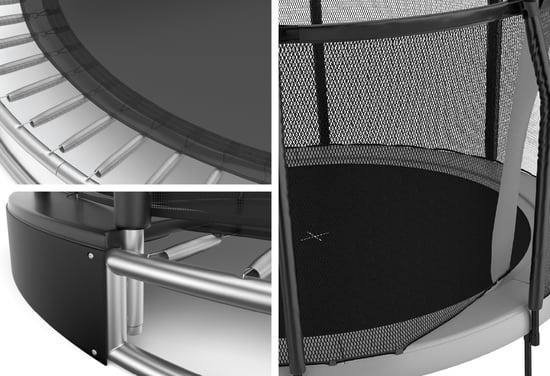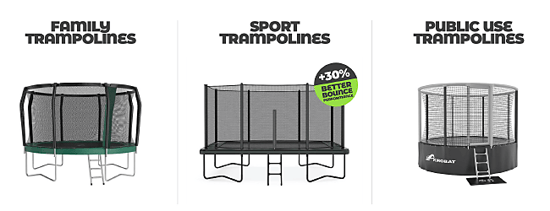Have you ever wondered, while jumping on a trampoline, how much weight it can take? The weight limit of a trampoline is one of the key details you need to know before buying one, so it’s a good idea to learn a thing or two about the subject.
In this article, we'll look at what the weight limit on a trampoline is, why it's important, and how to determine it. After reading it, your next trampoline purchase will definitely be faster and easier.
What’s the weight limit on a trampoline?
So, before choosing the right model for your family you should think about the maximum load the trampoline will need to carry. This is called the weight limit of a trampoline, and it tells us how much weight or the maximum allowed weight of a user a particular trampoline can withstand.
The weight limit of a trampoline is defined by how high someone can jump relative to their weight and still land safely without reaching the bottom of the pit or touching the ground. Crucially, this also takes into account the increased downward force as a person jumps on the trampoline.
The weight limit is specified on all trampolines and it’s essential to never exceed the stated weight for safe and carefree fun. Exceeding the weight limit of a trampoline can both damage the trampoline and increase the risk of injury.
Why is the weight limit of a trampoline important?
The weight limit of a trampoline is a key piece of information that should never be overlooked when choosing a model for your garden. Knowing and respecting this limit is important for two reasons:
-
Safety: Can you imagine the pain you’d feel if you jumped high into the air and then hit the ground because the springs and jumping mat couldn’t take the load? This is something that can easily happen if you ignore the weight limit.
-
Durability: Because buying a trampoline is a long-term investment, you certainly don't want it to get damaged after just a few months of use. Exceeding the weight limit can cause overloading of the springs, the jumping mat, and the trampoline frame, which can then shorten the trampoline's lifespan.

Main factors affecting the weight limit of a trampoline
Different trampolines have different weight limits. This is due to a combination of factors, the most important of which are:
- Springs – they differ mainly in length and number. As a rule of thumb, the shorter the springs, the more weight they can support, and the more springs there are, the higher the trampoline's load capacity.
- Frame – the frame of the trampoline, must be made of strong and durable materials, as this is the only way it will be able to withstand all the stresses and strains that come with normal use. The way in which the trampoline is assembled, and the rust resistance of the frame, are also important considerations.
- Jumping mat – higher load-bearing capacity is ensured by a high-quality and denser weave, which prevents tearing and overstretching. Additionally, reinforced seams that fix it to the springs prevent tearing at the point where the jumping mat is attached to the springs.
- Trampoline size – the weight limit usually increases with the size of the trampoline. Older and bigger children tend to weigh more, as do adults, so you should choose a trampoline that’s big enough for everyone who might use it.
- Trampoline shape – rectangular trampolines generally have a higher load-bearing capacity than round trampolines.
How do I choose the right trampoline concerning the weight limit?
If you want to use your trampoline for a long time and ensure the safety of its users, it’s important to consider its weight limit. If your trampoline will mainly be used by children, each weighing between 30 and 40 kg, and the trampoline has a weight limit of 100 kg, it’s clear that the children's body weight is significantly lower than the weight limit of the trampoline.
The problem arises when you have several children jumping on the trampoline at the same time, or when a single jumper weighs more than 100 kg. Having several children jumping at the same time is already dangerous from a safety point of view, but it also puts a strain on your trampoline. The same applies if you have a user whose weight exceeds the trampoline's weight limit.
To avoid unpleasant situations due to not respecting the weight limit of a trampoline, follow the steps below to choose the right model for your home:
-
Think about who will use the trampoline – just your children or the whole family?
-
Weigh the children and family members who intend to use the trampoline. Take into account the fact that as children grow their weight will increase.
-
Choose a trampoline with a weight limit higher than the weight of the heaviest family member. This will ensure the safety of all users, as well as the longevity of the trampoline.
Every trampoline in our wide range of models has a weight limit clearly stated in the technical specifications. So be sure to pay attention to this information if you want your family to enjoy safe jumping and a high-quality trampoline with a long service life.
Discover our ultimate guide where we compile all the essential details you require to find the ideal trampoline tailored to your specific needs.

